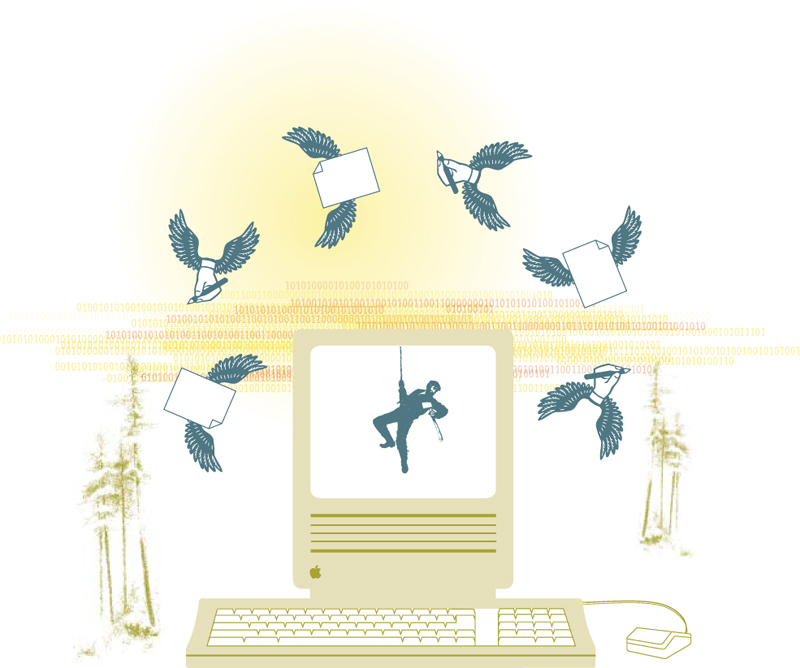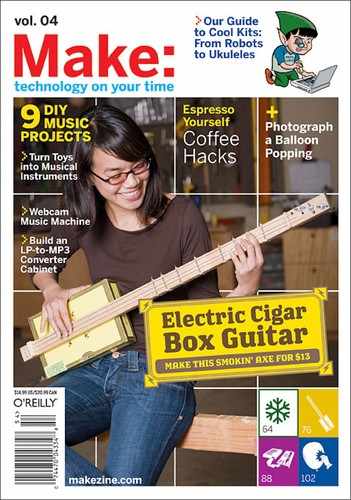Life Hacks: Overclocking Your Productivity
DEATH TO PAPER!
VIVA PAPER!
THE DEAD TREE VERSION IS ALWAYS BETTER THAN THE DIGITAL VERSION. EXCEPT FOR WHEN IT ISN’T.
By Merlin Mann & Danny O’Brien

Illustration by Kristy McKoy
YOU MAY RECALL, SEVERAL YEARS BACK, when the coroner’s report on paper came back with findings as grave as they were decisive. Owing to its purported cost, unwieldiness, and utter obviation by widely available clusters of zeroes and ones, the proud and pulpy sheet was reportedly as dead as Trotsky. Four thousand years in the loyal service of pharaohs, lovers, and child-artists just terminated without ceremony or recompense — made redundant, we were told, because simply everyone was using computers nowadays — so, why (God, why?) would any sensible person ever want to write something down again? I mean, really.
Visualize the bafflement among the paperphilic staff of Life Hacks Labs upon hearing from many of these same (albeit slightly rounder and greyer) futuristas that paper is now apparently “back.” And apparently paper has really caught on with geeks. Can you believe it? The same scoundrels who were placed in charge of all those computers that supposedly replaced paper back during the Clinton Administration! The very idea. The mind reels.
There is no Lumber Cartel. Friends, we’re here today to unveil the august secret that we hope will save potentially dozens of Important Technology Writers from needing to produce another wide-eyed report on how very odd it is that all these geeks seem to love paper so much. The trick is that there is no paradox, no more so than suggesting that people who buy screwdrivers must necessarily hate drills.
Geeks rely on paper for the same reason that the normals do: paper — along with conceptual cousins like whiteboards and magnets — is simply the most efficient tool for completing certain kinds of cognitive work. And no amount of enhanced technology will likely diminish this anytime soon.
Paper’s in the room with you. The physicality of paper invites us to stack and tear and tape and fold and occasionally even fashion a missile to hurl at a beloved family pet. Paper is there, and it inarguably represents the purest and most durable instance of the WYSIWYG interface.
A pile of sticky notes and a blank wall brings a brainstorming session to life, while the modest index card lets us capture, pile, analyze, and quickly reorganize our thoughts in cognitively satisfying ways.
Paper likes a day off as much as anybody. This is not to imply that our tasks can’t all be accomplished with the help of an appropriate digital device. We’ve each seen the outsize functional yield of one beardy hacker, a Perl install, and a couple of spare afternoons. It’s more to suggest that paper affords presence and immediacy for the tasks that require our minds to be open, ductile, and generative. If you’ve mastered an electronic tool to the extent that paper seems to impede your flow, then more power to you.
But even in the rarified geek subculture of Extreme Programming, we find paper to be front and center. Index cards are employed in abundance, with clients writing user stories, developers tracking tasks, and the cards themselves serving as physical reminders of progress and next steps.
“Our real challenge today is not to use less paper but to keep less paper.”
Does this make my FedEx look fat?
Unfortunately, the physicality that makes paper so ideal for “thinking” tasks is the very quality that makes it ill-suited for storage, recall, and transmission over physical distance; paper takes up space, weighs something, and can, in time, degrade in quality. Plus, until they finally build out that international network of pneumatic tubes we’ve been asking for, it’s likely that gzip and sftp will continue to lap faxing and shipping for both cost and efficiency.
Farmer and cowman should be friends. As Malcolm Gladwell noted in his 2002 New Yorker review of The Myth of the Paperless Office, our real challenge today is not to use less paper but to keep less paper. Paper still has a role in our lives — just not as the sole information tool we have at our disposal. We don’t throw out our wallets when we buy a new suitcase, and no one seems to mind living in a home that contains both a television and a radio. Likewise, there’s plenty of room for paper and digital to live alongside each other so long as we remember and respect what each is better at.
For ubiquitous capture, planning, and brainstorming, paper’s tough to beat. For storage, searching, and editing, the point goes to digital. As for organizing and outlining? Your call. But whatever you decide to use and for whatever purpose, it’s comforting to know that the chance for a fresh start is always waiting at arm’s length on a penny’s worth of plain old paper.
Learn how to reel in your mind at Danny O’Brien’s lifehacks.com and Merlin Mann’s 43folders.com.
MakerFaire
![]() Meet expert Makers and MAKE contributors
Meet expert Makers and MAKE contributors ![]() Hear from O’Reilly’s Hacks authors
Hear from O’Reilly’s Hacks authors ![]() Attend DIY tutorials
Attend DIY tutorials ![]() Explore DIY projects and demonstrations
Explore DIY projects and demonstrations ![]() See the Ultimate Workshop
See the Ultimate Workshop
Bring your family and friends to the San Mateo Fairgrounds (centrally located in the San Francisco Bay Area) for a weekend of hands-on exploration, recipe-sharing, creative mischief-making, and wholesome play. All-day admission is a paltry $12 adults, $5 teens, and not a cent for kids 12 and under accompanied by an adult. Maker-friendly family tickets and full weekend passes available as well!
